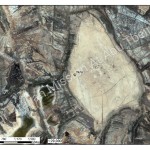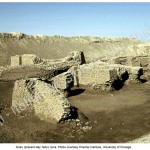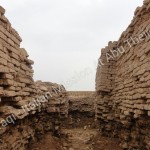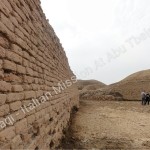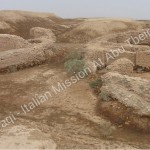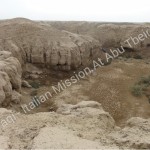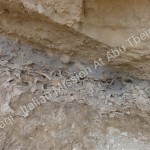Modern name:
Telloh
Ancient name:
Girsu
Geographic coordinate:
31° 33′ 35.9928″ – 46° 10′ 11.9712″
31.5599987° N – 46.169992° E
Governatorate – District – Sub-district:
Dhi-Qar – al Rifa’i – al Nasir
Nearest City:
About 20-25 kilometers north-northwest of Lagash and 19 km south-east from al Rifa’i.
Chronological frame:
Early Dynastic period, 2500-2300 BC; the city lost importance thereafter but remained inhabited until 2nd century BC.
Excavations:
Tello was the first Sumerian site to be extensively excavated. The French vice-consul at Basra, Ernest de Sarzec, worked there from 1877-1900 and sent spectacular finds from the site to Paris. These included masterpieces of Sumerian art such as the beautifully carved statues of Gudea. Subsequent excavations were undertaken by the French: in 1903-9, 1929-31 and, the most important, directed by A. Parrot in 1931-33.
Description:
An important Sumerian city, part of the Lagash city state, source of thousands of cuneiform tablets.
During the Early Dynastic period, Girsu might have been the political center of Lagash, and in later periods, played an important religious role, housing the temples of Ningirsu,chief god of Lagash, and his wife Bau. Early excavations by a French team led by Ernest de Sarzac (French vice-consul at Basra) in the 1870s yielded important cuneiform archives, and the first identification of a distinct new culture, the Sumerians. The tablets deal with temple accounts and economy, the original interpretation was that the Sumerian city-states were essentially theocratic with the gods owning all the land, and the terms “temple state” was developed. Later scholarship has shown this was an inaccurate and incomplete affirmation, and that the palace was equally important, and there was also private land ownership.
While the French tried to do what they could to prevent site looting, it is estimated that between 35,000-40,000 looted tablets from Girsu have appeared on the market as opposed to about 4,000 tablets excavated by the French. Other important discoveries include the many statues of Gudea and his dynasty, carved in diorite, a large silver vase dedicated to Ningirsu by an ruler, Etemena, and the famous “Stele of the Vultures” celebrating a victory by Eannatum.
Nome moderno:
Telloh
Nome antico:
Girsu
Coordinate Geografiche:
31° 33′ 35.9928″ – 46° 10′ 11.9712″
31.5599987° N – 46.169992° E
Governatorato-Distretto-Sub-distretto:
Dhi-Qar – al Rifa’i – al Nasir
Città più vicina:
A circa 20-25 chilometri a nord-ovest di Lagash e a 9 km a sud-est di al Rifa’i.
Quadro cronologico:
Proto-dinastico, 2500-2300 aC; la città successivamente ha perso importanza , ma è rimasta abitata fino a II secolo aC.
Scavi:
Telloh è stato il primo sito sumero ad essere ampiamente scavato. Il vice-console francese a Bassora, Ernest de Sarzec, vi lavorò 1877-1900 e ha inviato ritrovamenti spettacolari dal sito a Parigi. Questi includevano capolavori dell’arte sumerica, come le statue di Gudea splendidamente intagliate. I successivi scavi sono stati effettuati dai francesi: nel 1903-9, 1929-31 e, il più importante, fu diretto da A. Parrot nel 1931-1933.
Descrizione:
Un importante città sumera, parte della città-stato di Lagash, fonte di migliaia di tavolette cuneiformi. Durante il periodo protodinastico, Girsu potrebbe essere stato il centro politico di Lagash, e in epoche successive, ha svolto un ruolo religioso importante, ospitando i templi di Ningirsu, principale dio di Lagash, e di sua moglie Bau. I primi scavi da parte di un team francese guidato da Ernest de Sarzac ( vice-console francese a Bassora) nel 1870 ha prodotto importanti archivi cuneiformi, e la prima identificazione di una nuova cultura distinta, i Sumeri. Le tavolette affrontano i conti del tempio e l’economia, l’interpretazione originale fu che le città-stato sumeriche erano essenzialmente teocratiche con gli dei che possiedono tutto il paese, per questo venne sviluppato il termine “città tempio”. Gli studiosi in seguito hanno dimostrato che questo fu un’affermazione imprecisa ed incompleta, e che il palazzo è stato altrettanto importante, e c’era anche la proprietà terriera privata. Mentre i francesi hanno cercato di fare tutto il possibile per impedire i saccheggi del sito, si stima che tra 35.000-40.000 tavolette saccheggiate da Girsu sono apparse sul mercato in contrasto alle circa 4.000 tavolette scavate dai francesi. Altre scoperte importanti sono le numerose statue di Gudea e della sua dinastia, scolpite nella diorite, un grande vaso d’argento dedicato a Ningirsu da un sovrano , Etemena, e la famosa “stele degli avvoltoi” festeggiante una vittoria di Eannatum.
